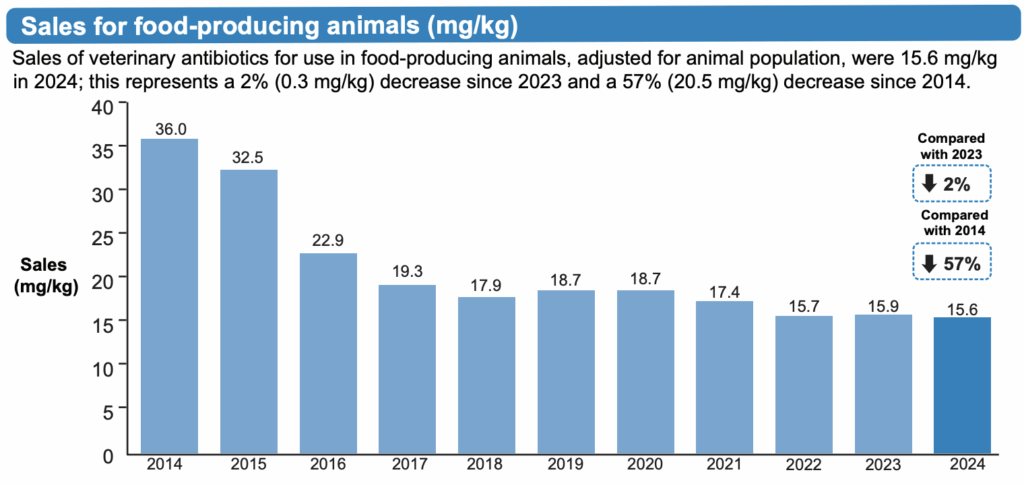Sales of veterinary antibiotics in the UK fell to a new low in 2024, according to the latest Veterinary Antimicrobial Resistance and Sales Surveillance (VARRS) report.
The report, published today by the Veterinary Medicines Directorate (VMD), shows sales of veterinary antibiotics for use in food-producing animals, adjusted for animal population, were 15.6 mg/kg in 2024.
This represents a 2% (0.3 mg/kg) decrease since 2023 and a 57% (20.5 mg/kg) drop since 2014 and means the UK remains one of the lowest prescribers of veterinary antibiotics in Europe.
Over 50% of all antibiotics were sold were either tetracyclines (31%) or penicillins (26%). Sales of highest priority critically important antibiotics (HP-CIAs) in food-producing animals remained at very low levels at 0.06 mg/kg, accounting for 0.4 % of total sales.

Pig sector usage
The report shows pig sector usage increased slightly to 50mg/kg in 2024, but this still represented a 69% decline on 2015 levels. Use of HP-CIAs in the pig sector also inched up slightly but remained at negligible levels, just 0.005mg/kg, 99% down on 2015 levels.
The latest VARSS report uses a new metric for antibiotic sales and use in food producing animals, which better represents UK animal populations and allows the UK data to be compared with data across Europe. While the mg/kg figures are different, appearing ti be lower, the trends remain the same.
Reduced AMR
The report shows the UK livestock sector has also achieved some of the biggest reductions in AMR across Europe in the last decade
Recent data published earlier this year from the Animal Plant and Health Agency (APHA) and VMD reveals a strong link between reduced antibiotic use and reduced antimicrobial resistance in animals.
This year’s report presents a decade of clinical surveillance data for the first time. In most animal species, there are clear declines in resistance, reflecting the sustained efforts to reduce antibiotic use across the farming sector and keep antibiotics working, the report said, adding that this mirrors the overall reduction in AMR carried by healthy animals at slaughter.
AMR occurs when bacteria and other microorganisms evolve to resist antimicrobial drugs like antibiotics, rendering these treatments less effective or even ineffective in animals and people. More than 39 million deaths directly attributable to bacterial AMR will occur between now and 2050.
Abi Seager, Veterinary Medicines Directorate CEO said: “This year’s report shows that through the ongoing hard work of vets and farmers across the UK we can make real progress in the fight against AMR.
“Overall use of antibiotics in livestock remains at its lowest level and importantly use of the most critical antibiotics for human health remains extremely low. This is reflected in results from our AMR surveillance programmes, which show an encouraging picture of AMR reducing in animals.”
Baroness Hayman, Minister for Biosecurity, Borders and Animal Welfare, said: “Through combined efforts across Government and industry we continue to make progress in reducing the use of antibiotic in animals, which is vital for public and animal health.”
Targets Task Force report
The latest RUMA Agriculture Targets Task Force (TTF) Report has been released today, marking the final update in the RUMA Targets Task Force 2 (TTF2) cycle, charting another positive year of antibiotic stewardship across UK livestock sectors. RUMA is set to launch the third cycle of targets, TTF3, next week.
RUMA CEO Cat McLaughlin said: “The continued effort and commitment from across UK livestock sectors remains clear to see in both the VARSS and the RUMA Agriculture Targets Task Force reports While reductions in use have been significant over the past decade, we are starting to see a plateau in reduction levels.
“It is vital that sectors still have the ability to use antibiotics when it is appropriate to do so – right time, right place, right situation.”
NPA chief policy adviser Katie Jarvis said: “It is positive to see that the UK is a leading nation in the fight against AMR.
“Usage in the pig sector has increased this year due to a rise in some pig diseases, the removal of zinc oxide and problems with the availability of vaccines. However, the trend remains positive with a continuous decline in usage of 69% since 2015.
“Antibiotic usage will fluctuate as the sector continues to use as little as possible but as much as necessary and we do now anticipate that some years will present more of a challenge. The pig sector remains committed to a continued reduction in antibiotic use.”




